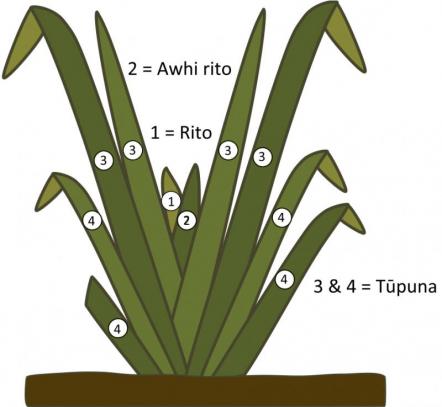Harvesting harakeke
Aim
To understand that there are protocols and processes related to collecting harakeke.

The leaves of harakeke are like a whānau. New leaves grow in the centre of the plant. These youngsters are called rito and are protected on each side by the awhi rito leaves. All the leaves share the roots and gain strength by being part of the whole plant.
- Why do you think it is important not to cut the rito and awhi rito leaves?
- Why do you think it is important to cut the leaves at an angle pointing away from the plant?
- Does it make sense to you that harakeke is likened to a whānau?
- Why it is important not to cut the leaves when it has been raining?
Whakataukī and waiata for harvesting harakeke
Many of our whakataukī about harakeke can tell us a lot about caring for the environment.
Discuss with a friend why you think the message in the whakataukiī below is true for harakeke?
Tungia te ururoa, kia tupu whakaritorito te tupu a te harakeke
Burn the undergrowth so the flax will shoot up.
(Clear away what is bad and the good will flourish.)
Hutia te rito o te harakeke
Kei whea te kōmako e kō?
Kī mai ki ahau
He aha te mea nui
o tēnei ao?
Māku e kī atu
He tangata, he tangata, he tangata.
- What do you think this waiata means?
- Why will the kōmako (korimako) have nowhere to sing?
For teachers
This popular and well-used waiata has been interpreted by many of our whānau, hapū and iwi. Here is another interpretation. The disappearance of the song of the kāmako (korimako) can be likened to the loss of children singing. Without children, mankind will not survive. If the rito leaves are removed, the harakeke will die. And without the nectar from the harakeke, we will lose the birds. This waiata reminds us of the relationships within a community, especially when it involves the use of resources.
